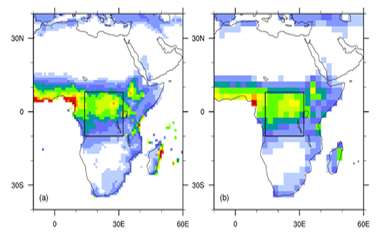Solving the puzzle of drought in Central Equatorial Africa

Central Equatorial Africa (CEA) has experienced a long-term drying trend over the past two decades and this drying trend may have reduced forest greenness and water content over the Congolese rainforest, the second largest rainforest in the world. Now, a research team led by UAlbany Associate Professor of Atmospheric Sciences Liming Zhou may have found out the possible cause.
The long-term drought during April, May and June over CEA may reflect the large-scale response of the atmosphere to tropical sea surface temperature (SST) variations. Likely the drought results primarily from SST variations over Indo-Pacific associated with the enhanced and westward-extended tropical Walker circulation (the large-scale atmospheric circulation over the Equator). These changes tend to induce subsidence and decrease convection over the Congo Basin, which lead to the reduction in low-level moisture transport and rainfall across the area. What remains to be determined is if these changes are the result of natural variability or global warming due to human activities.
Appearing in Environmental Research Letters, Zhou's team states that these results reinforce the notion that tropical SSTs have large impacts on rainfall over equatorial Africa. The authors argue that more work needs to be done to further distinguish the contribution of SSTs changes (such as a La Niña-like pattern and Indian Ocean warming) due to natural variability, or 'anthropological forcing' such as greenhouse gases or aerosol pollution.
"The Congo rainforest has experienced a long-term drying trend since the 1990s while similar droughts are absent in other tropical rainforests," said Zhou. "Tropical rainforests have the potential to modulate regional and global climatic changes via various feedbacks. Hence, understanding the nature and cause of this drought and assessing its impacts on the forests are of significant societal, economic and environmental importance."
Oceanic conditions, especially SSTs, have been highlighted as the driver for rainfall variations over Africa and other regions. SSTs modulate the rainfall variability not only via their direct and indirect impacts on atmospheric circulation, but also via their effects on moisture transport.
Over the long-term, the drying trend is likely associated with rapid warming in the Indian Ocean and warm pool. Tropical SSTs in other regions also have experienced obvious changes since 1979, with significant warming from the Atlantic to the western Pacific, and cooling in the central and eastern Pacific. These changes contribute to regional climate change through atmospheric 'teleconnections' (anomalies related to each other at large distances, typically thousands of kilometers). Even from halfway around the world, the Pacific Ocean has an indirect influence on African rainfall, as well as over the continent. But it remains to be seen if these changes are the result of human activity or internal variability.
"The changes in Pacific SSTs are likely due to natural multi-decadal variability. In contrast, the tropical Indian Ocean SST warming may result from global warming due mostly to human activities," said Dr. Wenjian Hua, lead author of the study and a postdoctoral fellow under the supervising of Prof. Zhou at Albany. "Whether the recent La Niña-like SST pattern is externally forced or internal variability is still unclear."
More information: Wenjian Hua et al. Possible causes of the Central Equatorial African long-term drought, Environmental Research Letters (2016). DOI: 10.1088/1748-9326/11/12/124002
Journal information: Environmental Research Letters
Provided by University at Albany



















